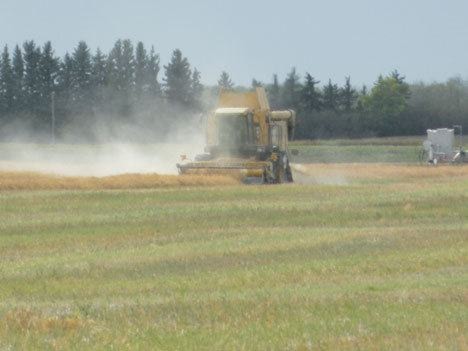Barry Yaremcio
Beef and Forage Specialist
Producers may find it necessary to feed more animals than anticipated during times of drought and resulting feed shortages. In such situations, additional feed requirements may partially be met by the harvesting of annual crops to supplement current hay production and carryover stocks.
Points to consider when using annual cereals as forages for livestock:
• Feed test forages, grains and straw prior to the start of the feeding period. Develop balanced rations to prevent production and reproduction problems, optimize the use of feeds available and to minimize costs. If help is required to balance rations, talk to a qualified nutritionist. Young animals are fed to grow and development. Mature stock is fed to maintain condition over winter and to provide a live calf next spring. The winter feeding program this year can dramatically affect reproductive efficiency for next year’s calf crop.
• Feeding cereal forage is different than feeding mixed alfalfa grass hay. Calcium, magnesium and potassium levels are different. A 1:1 mineral may not work in these situations. Feeding additional limestone and magnesium in the ration is often required to prevent problems with downer cows, milk fever, and winter tetany.
• Rough awned barley and foxtail barley have barbed awns. When consumed, the awns can become lodged in the gums or between the teeth and gums or in the cheeks creating abscesses and “lump jaw”. If rough awned material is part of the feed supply, provide breaks in the feeding period where alternate feeds are provided to the animals. A two or three day rotation between the rough awned feeds and other feeds will allow time for injuries to heal. This may help reduce the severity of the problem. If problems do occur, consult with your local veterinarian for treatment.
• Under drought conditions, annual crops may contain high levels of nitrate in early to mid summer. Drought stress reduces the plant’s ability to grow and utilize nitrogen normally. Test the forage for nitrate levels to determine what level is present. Cows can adjust and adapt to higher nitrates in feed over a period of time. The concentration of rumen bacteria that degrade nitrate increase over four to seven days. This short-term adaptation, along with the development of more red blood cells to transport oxygen to the tissues over 14 to 21 days, improves the ability of the animal to withstand higher nitrate feeds. Providing feeds with high starch content such a grain or pellets help detoxify nitrates. Consult with a livestock specialist or nutritionist to resolve potential problems.
• Breeding efficiency, or the ability of the cow to conceive a calf, can be compromised if cows are turned in to graze crops that were heavily fertilized with nitrogen fertilizer or manure. As animals consume forages with high protein levels, blood urea levels (BUN) also increase. The high BUN levels interfere with the implanting of the fertilized egg onto the uterine wall. This problem occurs when the overall protein content of the ration is in excess of 20 to 22% on a dry matter basis. Cows will appear to settle, but come back into heat three to four months later. Provide straw or other low quality forage on a free choice basis to reduce overall protein consumption.
• Moving cattle abruptly from a drought stressed grazed pasture with minimal forage available to a lush salvage crop or pasture can cause Atypical Interstitial Pneumonia. The disease occurs within 10 days of movement onto the improved forage. Affected animals emit a grunting noise when breathing and do not want to walk. If sick animals are forced to move, they may collapse and die.
• Forages mature more quickly in a drought year compared to a normal year. Quality is reduced as the forage matures. When making silage or greenfeed, cut forages one to three weeks earlier than normal to maintain quality. Plants that have turned white during the heat will not have adequate moisture to develop a proper fermentation. The crop will have a reduced sugar content compared to a normal year and will take longer to ensile. Diligence is required to maintain proper moisture content during the harvesting period, chop length, adequate packing and covering with plastic. Round bales must be placed in a tube or wrap within 12 hours of baling. Otherwise the fermentation process will be impaired by unwanted microbes.
• The nutrition topics addressed above can be evaluated by using a ration balancing program. Producers can develop their own rations at home. A useful computer program is the “Cowbytes” ration balancing program available from Alberta Agriculture and Rural Development. A demo version is available on Ropin’ the Web.
For more information contact:
Ag-Info Centre at 310-3276 (Farm)
